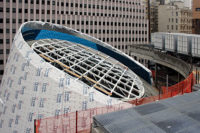

The parks, green spaces and sidewalks blend with the architecture to give residents and visitors alike a sense of place and community. The guidelines of I’On cultivate a thoughtfully designed community that provides visual harmony among buildings through use of appropriate architectural proportions, elements and details. This included columns.
“I wanted columns to be a critical component in the design of my home,” says Macky Hill, design coordinator for the I’On Group. “I wanted them to look like ‘the gun deck of an old frigate’ with a line of beams on both sides of the house. Beginning on the portico in the front of the house, columns were placed every 8 feet 6 inches and continued on through the interior of the house, back out to the exterior of the back porch. (Note: The rule is that columns should be no further apart than they are tall, with the height of each column being 8 feet 6 inches, the distance between each column would also be 8 feet 6 inches).
Hill likes the look of a formal house, but his lifestyle—busy family with three children with lots of friends and dogs, is informal. The outward look is that of polish and formality, the inside is ‘finished’ looking, but still fits the family’s lifestyle.

Tie that supports
Aesthetically, columns tie the whole house together.“One good thing with an open floor plan, columns require you to line up walls above it, which reinforces the floor plan on the second and third floors as well,” says Hill. Tim Hager, of Hager Builders, installed laminated beams on top of the columns, 3 1⁄2 inch by 12 inch by 10 feet to span the distance between the columns adding extra support for the second floor in open areas.
Chadsworth’s 1.800.COLUMNS PolyStone Columns were used. The columns themselves are load bearing (each supports more than 10,000 pounds), but are less expensive than a traditional wooden column.
“The columns are resistant to extreme weather conditions but they can be used for interior jobs as well,” says Jeff Davis, the owner and principal designer of Chadsworth’s. “They are constructed of reinforced polyester resin, fiberglass and marble dust. The wall thickness for 8- and 10-inch bottom diameter columns is 1/2 inch; 12- to 16-inch bottom diameters is 1/2- to 5/8-inch. The columns feature a true architectural taper and a classical bead. The Tuscan capitals and basis are made from the same tough material as the shafts. PolyStone columns do not require ventilation and are ready to prime and paint for exterior or interior application.”
“All the wood trim used on the interior of the house is basically over scaled exterior Tuscan entablature,” says Hill. “Cornices around the interior are the same as what we used on the exterior. We did that to tie the interior to the exterior and also to achieve an overall massiveness. The same exterior paint was used on the columns and trim, because we wanted continuity inside and out.”

Southern charm
“In my job, I address modern design problems with traditionally based answers, to end up with a timeless look, and that is what I did in building my house,” says Macky. “It is important to have a ‘flow’ between the inside and outside of a home. The unifying feature between the outdoors and the indoors are columns. They start on the porch as part of the house and continue inside.”Macky grew up in Charleston and is an authority on the architecture and culture of the Low Country.
“Long before air conditioning, in the heat of Charleston, the exterior was as important as the interior, the piazzas were used as another room,” says Hill. “Houses had large piazzas (porches) because in the summer people lived on them. They ate there, and slept there as well. A 20-foot porch would sleep a household of ten people plus their servants. The exterior was tied to the interior. That is also why Charleston has such private gardens. Everything flows outside because of the heat,” says Hill.
“Columns were the right solution for this house, they opened up the space, and made the area seem larger,” says Hager. “They also provided extra strength and durability.” W&C


Report Abusive Comment